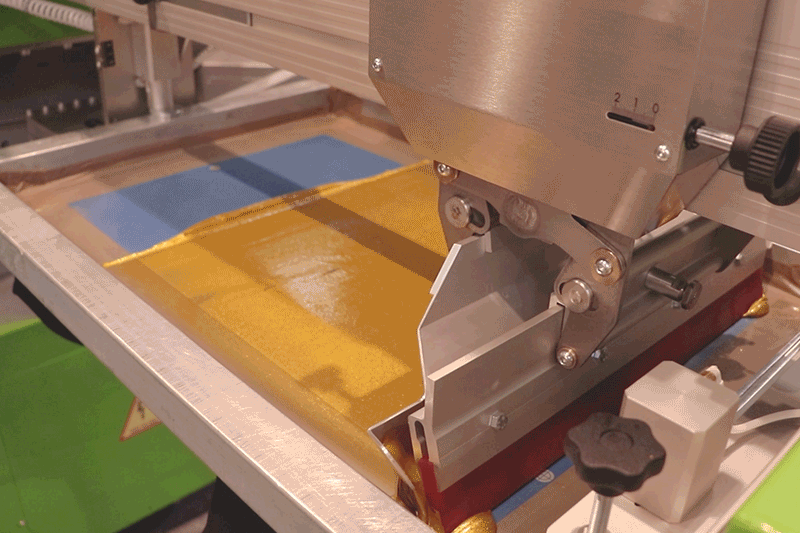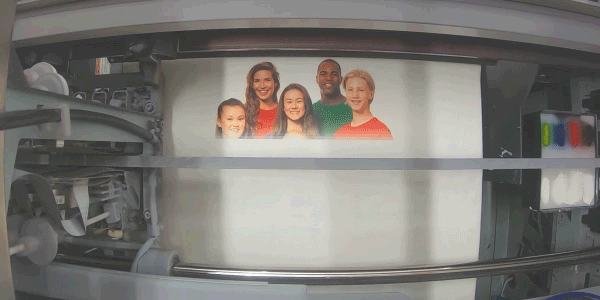Textile print methods
Screen print
Screen print is a traditional ancient Chinese printing form. You varnish on a silk fabric strung on a wooden frame where there should be that marks the area of the print where there should be no color, and thus you had a template to print after. Today we use a nylon fabric clamped on a typical aluminum frame.
A light-sensitive emulsion is applied to the fabric. On the fabric a film is applied which is dark in the areas where the color is to be printed through. The frame is illuminated with ultraviolet light, thereby hardening the areas not covered by the black surfaces of the film. When the frame is rinsed with water, the uncured areas are washed away and we have a template. The textile dye is printed directly into the fabric through the template using a rubber squeegee. The fabric is heat-fixed and the printing is complete.
We currently have four automatic direct printing presses - from the smallest with 7 printing presses and up to the largest with 11 printing presses.
The largest print we can make is 45 x 67 cm (though with certain restrictions, please ask). A "normal" large print is within 40 x 70 cm.

Screen printing on different colors
Solid black print on white T-shirt - it is simple and uncomplicated, we print it as it is, and almost anything can be done.
But inks are transparent, and the color of the fabric will always influence the design. Therefore, printing on dark goods requires special conditions. To keep the value of the colors, we usually print a white surface under the motif on dark items. Is there a job with a white print on black textile, we print the white color twice to make sure it covers. If there is red print on black textile, we first print a white surface, and after intermediate drying (flash) we print the red color on top.
In the case of multicolor printing on dark textiles, the printing can be even more complicated. Photographs or photorealistic motifs must also be printed on a white background, but they require a special separation technique for making the films.
When there are many colors in a print on dark goods, we always want to assess the motif before we can decide how it should be printed. But you as a customer do not have to think about or pay for the extra surface printing or intermediate drying, as they are included in our prices. However, we have an exception when printing with neon color. This requires us to press a white bottom twice and this is not included in the price.
Transferprint
A transfer is a piece of specially treated paper on which we serigraphically print the motif mirrored. The transfer is placed on the item and heated under pressure. When the paper is removed, it leaves the print facing the item and the print is finished. The transfer is applied to the fabric and held in place by an adhesive layer which has been applied to the transfer after printing and is melted into the fabric. We always use transfers on caps, but the extent to which we use transfers on other items depends.
For transfer production, we have 3 production lines. For transfer transfers we have 5 heat presses with double plates, a heat press with single plate and three heat presses for caps.
The assessment of whether a print should be made as a direct print or transfer is individual and difficult to generalize.
Lithographic transfer
Or just "litho" is offset printing on transfer paper, serigraphically built on water-based paint and glue. We typically use litho for photographs or photo-like subjects, which we separate into 4 colors (CMYK; cyan, magenta, yellow, and key). Motifs are printed upside down on transfer paper together with glue. Then - as with transfer printing - the transfer is transferred to the fabric and melted onto it.
Cutting plot transfer pressure
When the print is to be transferred to special fabric, for example softshell or nylon, we use cutting plots. The design is printed on a special foil and cut around (which requires the design to be bounded all the way by a cut line) by the plotter printer machine in such a way that the back of the foil is still in one piece. The areas outside the print motif must be peeled off and the motif can then be transferred to fabric.
We also use the plotter, however without printing, only with cutting when the motif is solid color and requires special effect, for example glossy metal color.
DTG (Direct to garment)
With this method, a special garment-printer prints directly onto the fabric. On white and light fabrics, the color is embedded right into the clothes. On dark fabrics, we first print a thin white layer to ensure that the other colors cover, therefore the print is on top of the fabric.
DTG technology is well suited for detailed graphics or photography. We do not make any films, therefore there is no limit on the number of colors. With a smaller number of prints in your order, DTG can be a price advantage compared to direct prints or transfer prints. At DTG, we press "on demand", also all the way down to one piece.
